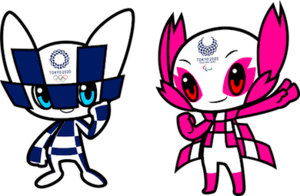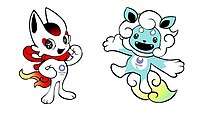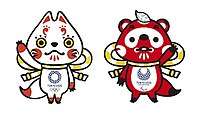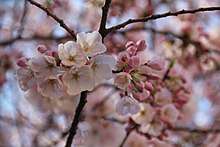Miraitowa and Someity

| Part of a series on |
|
| Part of a series on |
|
Miraitowa (Japanese: ミライトワ; pronounced "mee-rah-e-toh-wa"[1]) is the official mascot of the 2020 Summer Olympics, and Someity (Japanese: ソメイティ; pronounced "soh-may-tee"[1]) is the official mascot of the 2020 Summer Paralympics. Both events are scheduled to be held in Tokyo, Japan. The checkered design on both mascots was inspired by the Tokyo 2020 official logo, while Someity's pink design was inspired by cherry blossom flowers. Both fictional characters have various superpowers, such as teleportation.
Created by Japanese artist Ryo Taniguchi, the mascots were selected from a competition process which took place in late 2017 and early 2018. A total of 2,042 candidate designs were submitted to the Tokyo 2020 Organising Committee, which selected three pairs of unnamed mascot designs to present to Japanese elementary school students for the final decision. The results of the selection were announced on 28 February 2018, and the mascots were named on 22 July 2018. Miraitowa is named after the Japanese words for "future" and "eternity", and Someity is named after someiyoshino, a type of cherry blossom. Someity's name also references the English phrase "so mighty". The mascots are expected to help finance the Tokyo Games through merchandising and licensing deals.
History
Selection and naming process
In late 2017 and early 2018, the Tokyo 2020 Organising Committee held a competition to determine the design of the 2020 mascots. A total of 2,042 design submissions were accepted between 1 August and 14 August 2017. The entries were then subjected to a series of format and design examinations led by media specialists and the Organising Committee's Mascot Selection Panel to determine whether they "would appeal to elementary school-aged children" and whether they "amply reflected the spirit of the Tokyo 2020 Games Vision".[2]


By mid-October 2017, this process reduced the pool to a shortlist of three sets of mascot candidates, which were unveiled on 7 December 2017. Each set included two mascots: one for the Olympic Games and the other for the Paralympic Games.[2] Between 11 December 2017 and 22 February 2018, an election was conducted across 16,769 Japanese elementary schools to choose the winning entry, with each participating elementary school class allocated one vote.[3][4][5] In total, 205,755 elementary school classes participated in the election.[5]
| Pair | Designer | Votes received[5] | Profile |
|---|---|---|---|
| A (winner) | Ryo Taniguchi (Japanese: 谷口亮) | 109,041 | [6] |
| B | Kana Yano (Japanese: 矢野花奈) | 61,423 | [7] |
| C | Sanae Akimoto (Japanese: 秋本早苗) | 35,291 | [8] |
The results were announced without names on 28 February 2018. The winning entry was candidate pair A, created by Ryo Taniguchi.[5] The Mascot Selection Panel held a vote on a shortlist of proposed names on 28 May 2018, and names with the most votes were subjected to a trademark verification process before they became official.[9] The names of the mascots, Miraitowa and Someity, were announced when the mascots made their formal debut at a press event on 22 July 2018.[10]
Characteristics
Miraitowa, the Olympic mascot, is a figure with blue-checkered patterns inspired by the Games' official logo. It is intended to embody "both old tradition and new innovation". The character has a "strong sense of justice" and is described as "very athletic". It has the ability to superfast and teleport anywhere instantly.[11] Miraitowa is named after the Japanese words mirai (future) and towa (eternity) combined.[10] According to the Tokyo 2020 organizers, the name "was chosen to promote a future full of eternal hope in the hearts of people all over the world".[1]

Someity, the Paralympic mascot, is a figure with pink-checkered patterns inspired by cherry blossom flowers and also the Games' official logo. The character is described as "usually calm" but can become "very powerful when needed". The character has the special ability to flight using a pink-checkered cape and cherry blossom-shaped antenna to "talk to stones and the wind" and can also move objects by looking at them.[11] Someity is named after someiyoshino, a type of cherry blossom, and it is also intended to refer to the English phrase "so mighty".[10]
Although the two mascots have conflicting personalities, they nonetheless have a strong friendship and respect for each other.[11] According to their fictional backgrounds, Miraitowa and Someity "live in the digital world", and through the Internet, they can transport themselves between the digital world and the real world.[12] According to Sadashige Aoki, an advertising theory professor at Hosei University, the mascots follow a Japanese tradition of "creating personalized characters out of nature — mountains, rivers, animals and plants", as well as a "tradition of animism, a belief that every natural thing has a soul".[13]
The mascots were designed by Japanese artist Ryo Taniguchi, who lives in the Fukuoka Prefecture in southern Japan. Taniguchi was persuaded by his father, who is also an illustrator, to study art at Cabrillo College in California.[14] He has illustrated English-language textbooks for Japanese children.[14][15] Taniguchi was uninvolved in the naming of the mascots, though he did attend a screening at which various naming proposals were introduced.[14] As part of the agreement to use the mascots, Taniguchi transferred intellectual property rights to the mascots to the Olympic and Paralympic committees, and as a result, he will not receive any royalty payments from mascot-related licensing.[16]
Media
Merchandising
The mascots are expected to generate revenue to help finance the Tokyo Games.[13] An Olympic official expected the mascots to generate $130 million (¥14.4 billion) in revenue from licensing and merchandising.[14] The organizers of Tokyo 2020 had been criticized for its budget management.[15][17] According to Reuters, a 2016 study found that overall expenses for the Olympics could be "four times the initial estimate made in the bid process".[17] Tokyo 2020 must transfer intellectual property rights to the mascots to the International Olympic Committee and the International Paralympic Committee after the Games are concluded, which would prevent Tokyo from licensing and developing the mascots after the Games are over.[13]
From late July to early September 2018, a "Mascot House" was located on the first floor of the Tokyo Midtown Hibiya building, where visitors could take photos with the mascots and purchase licensed merchandise featuring the mascots.[18]
Reception
The public reaction to the mascot selection was "generally positive", according to an article published on Forbes' website in March 2018 by contributor Jake Adelstein. Adelstein described the mascots as "cute", though he commented that "there was some criticism of the futuristic blue and pink characters falling clearly into traditional gender roles". Adelstein speculated that the mascots would support the Olympics in Tokyo financially.[15] Multiple observers compared the design of the mascots to that of the Pokémon franchise.[15][19][20] An article by Agence France-Presse described the social media reaction to the mascot selection on as "mixed". Some users commented that the mascots were "very Japanese and very cute", while others commented that the mascots should have been "more round" or "more huggable". Other commentators said that the selected design "appealed more to children whereas adults preferred the softer and more traditional options".[21]
Dan McQuade wrote in an article in sports news website Deadspin that it will be difficult for Miraitowa and Someity to match the popularity of Soohorang and Bandabi, the mascots of the 2018 Winter Olympics, citing statements from the BBC, which wrote that the 2020 mascots "have a tough act to follow", and The Japan Times, which wrote in a headline that the success of Soohorang and Bandabi "leaves Japan in a bind".[20][22][23] James Dator, in a blog entry published on the sports news website SB Nation, wrote that there is "nothing functionally wrong" with the mascot design, but felt that Sanae Akimoto's pair C was a superior candidate and should have been chosen instead. Dator also argued that children should not have been the ones to make the final decision.[24] On the other hand, Naoki Ogi, a Japanese pedagogy expert, emphasized the importance of the role of children in selecting the mascots, as opposed to adults.[15] Japanese author Rurika Suzuki said that the mascots have a "a very Japanese anime like quality", describing them as "brilliant and sporty and perfect for the Olympics".[15]
References
- 1 2 3 "Tokyo 2020 Mascots, Miraitowa and Someity have finally Debut!". Tokyo 2020. 22 July 2018. Archived from the original on 22 July 2018. Retrieved 22 July 2018.
- 1 2 "Tokyo 2020 Games Mascots". Archived from the original on 1 March 2018. Retrieved 7 September 2017.
- ↑ "2020 Tokyo Olympic organizers begin soliciting mascot ideas". The Japan Times. 1 August 2017. Retrieved 7 September 2017.
- ↑ "Tokyo 2020 lets children choose mascots from 3 finalists". NBC Sports. 7 December 2017. Retrieved 17 February 2018.
- 1 2 3 4 "Tokyo 2020 Unveils Olympic & Paralympic Mascots" (Press release). Tokyo Organising Committee of the Olympic and Paralympic Games. 30 May 2018. Retrieved 30 June 2018.
- ↑ "Mascot Candidates A". Tokyo 2020. Tokyo Organising Committee of the Olympic and Paralympic Games. Archived from the original on 25 February 2018. Retrieved 23 July 2018.
- ↑ "Mascot Candidates B". Tokyo 2020. Tokyo Organising Committee of the Olympic and Paralympic Games. Archived from the original on 25 February 2018. Retrieved 23 July 2018.
- ↑ "Mascot Candidates C". Tokyo 2020. Tokyo Organising Committee of the Olympic and Paralympic Games. Archived from the original on 25 February 2018. Retrieved 23 July 2018.
- ↑ "10th Meeting of the Mascot Selection Panel" (Press release). Tokyo Organising Committee of the Olympic and Paralympic Games. 28 February 2018. Retrieved 30 May 2018.
- 1 2 3 "Olympic mascots Miraitowa and Someity invoke the future and cherry trees for 2020 Games". The Japan Times. AFP-JIJI. 22 July 2018. Retrieved 22 July 2018.
- 1 2 3 "Tokyo 2020 Games Mascots". Tokyo 2020. The Tokyo Organising Committee of the Olympic and Paralympic Games. Retrieved 30 June 2018.
- ↑ "Tokyo 2020 Paralympic mascot named Someity". Official website of the Paralympic Movement. International Paralympic Committee. 22 July 2018. Archived from the original on 22 July 2018. Retrieved 22 July 2018.
- 1 2 3 "Cuddly and cute, but will Japan's Olympic mascots be cash cows?". The Japan Times. 23 January 2018. Archived from the original on 23 January 2018. Retrieved 8 July 2018.
- 1 2 3 4 Hueston, Dave (3 May 2018). "Tokyo 2020 mascot designer draws inspiration from the scenic route". Kyodo News. Archived from the original on 8 July 2018. Retrieved 8 July 2018.
- 1 2 3 4 5 6 Adelstein, Jake. "Japan's Cute Blue And Pink Mascots Are Here To Boost The Tokyo 2020 Olympics". Forbes. Archived from the original on 8 July 2018. Retrieved 8 July 2018.
- ↑ Gallagher, Chris (27 February 2018). "Olympics: Futuristic pointy-eared mascots chosen for Tokyo 2020". Reuters. Retrieved 9 July 2018.
- 1 2 Tarrant, Jack (22 April 2018). "Tokyo 2020 must address questions, says IOC's Coates". Reuters. Archived from the original on 24 April 2018. Retrieved 22 July 2018.
- ↑ "Tokyo 2020 Mascots". Tokyo 2020. Tokyo Organising Committee of the Olympic and Paralympic Games. Archived from the original on 16 August 2018. Retrieved 16 August 2018.
- ↑ Ashcraft, Brian (28 February 2018). "The Tokyo Olympic Mascots Look Like Pokémon". Kotaku. Archived from the original on 7 March 2018. Retrieved 8 July 2018.
- 1 2 McQuade, Dan (28 February 2018). "Will Japan's Olympic Mascot Be A Soohorang Or An Izzy?". Deadspin. Gizmodo Media Group. Archived from the original on 1 March 2018. Retrieved 12 July 2018.
- ↑ "Doe-eyed superhero picked for Tokyo 2020 mascot". The Straits Times. Singapore Press Holdings. Agence France-Presse (AFP). 28 February 2018. Archived from the original on 28 February 2018. Retrieved 11 July 2018.
- ↑ "Tokyo 2020 Olympic mascots unveiled after children's vote". BBC. 28 February 2018. Archived from the original on 28 February 2018. Retrieved 12 July 2018.
- ↑ Tanaka, Yukari (24 February 2018). "Success of Pyeongchang Olympic mascots leaves Japan in a bind". The Japan Times. Archived from the original on 12 July 2018. Retrieved 12 July 2018.
- ↑ Dator, James (28 February 2018). "Tokyo 2020 mascots aren't Stoned Cat and Leaf Bear because kids have no taste". SB Nation. Archived from the original on 28 February 2018. Retrieved 8 July 2018.
See also
- Cobi – mascot of the 1992 Summer Olympics
- Fuwa – mascots of the 2008 Summer Olympics
- Fu Niu Lele – mascot of the 2008 Summer Paralympics
- Misha – mascot of the 1980 Summer Olympics
- Sam – mascot of the 1984 Summer Olympics
- Vinicius and Tom – the mascots of the 2016 Olympic and Paralympic Games
External links
| Preceded by Soohorang |
Olympic mascot Miraitowa Tokyo 2020 |
Succeeded by TBA |
| Preceded by Bandabi |
Paralympic mascot Someity Tokyo 2020 |
Succeeded by TBA |